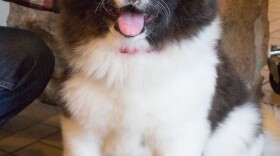Anyone who’s ever tried to pick their next best friend out of a stampede of big feet, slurping tongues, wiggly bodies and whipping tails knows that, when faced with a litter of puppies, the temptation is to just take them all home.
But when sled dog racers get a litter of puppies, it takes a while to know which puppies have what it takes to make a good sled dog. So all they can do is hang out with the puppies … and wait.

Dogs that race
In addition to what most of us think of as "sled dogs" (ie: Siberian huskies and Alaskan malamutes), Beargrease-goers will see a lot of “Alaskan huskies.” Alaskan huskies, unlike Siberians or malamutes, are not a breed of dog as much as they’re a category of dog. They were developed by mushers from various strains of Inuit dogs and can contain Siberian husky, malamute, hounds, pointers and even greyhounds in their genetic history.
Ann Stead calls them "throughbreds": dogs bred for the purpose of running in harness but not restricted to a set gene pool.

Ann has been racing sled dogs for over 40 years. She and four-time Beargrease champion Jamie Nelson have also spent the last few years teaching mushing boot camps all over the country. She took first place at the John Beargrease Rec Race in 2016 and she and her husband, Al, breed and train purebred Siberian huskies at their home outside Duluth.

Good feet, good health, and a good disposition
When choosing parents for a litter of potential sled dogs, Ann says she looks for:
- biddable dogs. Her Siberian Huskies are, she admits, independent by nature, but you have to have a dog who wants to work with you
- good feet. Any conversation about good sled dogs, regardless of breed, focuses on their feet above all else. “As go their feet, so go the dogs” is more than just a mushing expression. Ann looks for a good shape to the foot and a dog that stands up on its toes, not flat-footed.
- Good health is critical. The dog that never misses a race or a training run is a dog she wants as part of her breeding program

Ann says, for the most part, you can’t see what kind of potential a puppy will have as a racing dog until it’s about four months old and you can get it into harness for the first time.
From there, you give the puppies every opportunity to show you what they can do.

There’s only one exception to this evaluation of puppies based on their aptitude, and Ann is pretty sure every breeder of sled dogs feels the same way: the puppy that picks you.
That puppy, she says, is going to be given extra chances to prove itself and earn a spot on her team.
Go. Slow down. Stop.
No matter how good a puppy’s bloodline, or how tough and tenacious they are, Ann says the first times under harness with the half-grown youngsters is “hilarious.” At least two veteran dogs are hooked to a sled or ATV with 4-6 puppies. “They have to be,” laughs Ann, “otherwise you wouldn’t go down the trail at all. They go everywhere but straight ahead!”


Training is by the example set by the older dogs, and by vigilance and gentle correction from the musher. How do you correct a dog who’s maybe six dogs down the gangline from you? Stop the sled, says Ann, get down and remind them of their job. Then love ‘em up.
In addition to learning to run straight ahead, young sled dogs need to learn to pace themselves. Jason Rice, Beargrease Race director and former musher says dogs use different muscles to pull or to sprint, and it’s important that a marathon team find a slow, steady rhythm that will protect shoulders, wrists and feet. Running, full out, puts those critical joints in danger over time.

They also need to know how to stop. Jason says marathon dogs need to come into a checkpoint and take advantage of every opportunity to rest, without delay. The dog that lies down and goes instantly to sleep will be in better shape after a mandatory rest stop than the dog who’s wide awake, watching what’s going on around him.
Coming up, we’ll take a look at the “anatomy of a sled dog team,” introduce you to the way a racing sled works and the different jobs the dogs perform based on where they’re hitched along the gangline.
(Written and photographed by Lisa Johnson)







